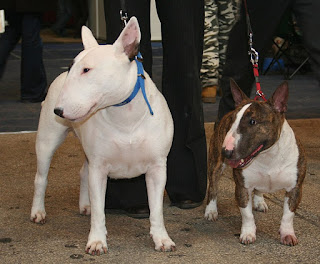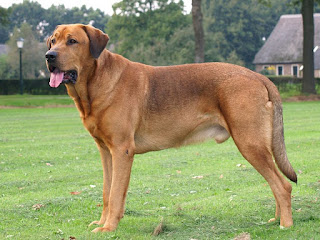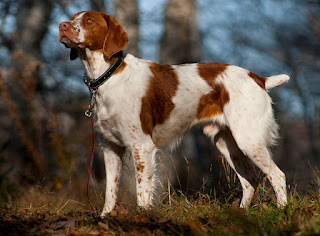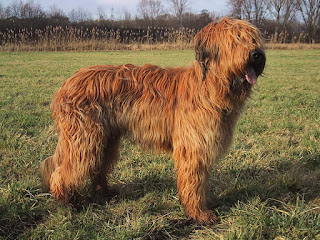The Bull and Terrier is an extinct type of
dog that was the progenitor of the American Pit Bull Terrier, American
Staffordshire Terrier, English Bull Terrier and the Staffordshire Bull Terrier.
History
The
Bull and Terrier is a cross between the Old English Bulldog and a variety of
Old English Terriers.
There
were several varieties of this combination between bulldog and terrier,
depending on the location(town or country) and the dogs chosen for the
crossing. In Ireland, they used the old Irish bulldog with different terriers
and some insertion of hunting sighthound/terrier crosses.[7][8] In England,
there were several varieties, among which three became known and survived until
the 1930s. These were the Walsall type, that had some influence from Whippet;
the Darlaston type, that had the major influence of terrier blood; and the
Cradley Heath type, that had more Bulldog blood. Phil Drabble reported that
among these three types of bull and terrier, the type of Cradley Heath was
recognized as a separate breed under name of Staffordshire Bull Terrier in
1935, and the other types gradually disappeared because they did not meet the
imposed standard. But decades earlier, in the 19th century, at least the
Walsall type was carried by immigrants to the United States, where it served as
an important component for the genetic basis of the American Pit Bull Terrier
breed, through specimens such as the dog Lloyd's Pilot and the Colby bloodline,
strongly combined with Irish strains.
The
anatomy of the Bull and Terrier is the result of selective breeding for the
purpose of hunting, dog fighting and baiting.
Hunting
Most
terriers, of the past and present, carried or carry a quarter to an eighth Old
English Bulldog blood in them in order, allegedly, to give courage to bear the
bites of the prey they are meant to attack. Terriers who were not developed
from crosses between the Old English Bulldog and earth-working dogs were of
inferior quality and were valued far less.
There
are earth-working dogs who by default and definition are called terriers
because they have the ability to go to ground; however, the best earth-working
and hunting terriers are the progeny of bulldogs bred to earth-working dogs
(terriers), also known as the 'Bull-Terrier' or 'half-bred' dog.
John
Henry Walsh wrote in 'The dog, in health and disease, by Stonehenge' (1859):
The
terrier as used for hunting is a strong useful little dog, with great endurance
and courage, and with nearly as good a nose as the Beagle or Harrier. From his
superior courage when crossed with the Bulldog, as most vermin-terriers are, he
has generally been kept for killing vermin whose bite would deter the Spaniel
or the Beagle, but would only render the terrier more determined in his pursuit
of them.
Walsh
also wrote of the Fox Terrier:
The
field fox-terrier, used for bolting the fox when gone to ground, was of this
breed (bull and terrier).
Not
only is the Fox Terrier the progeny of the Bull and Terrier, but so is the
Airedale Terrier, rat-working terriers, working black and tan terriers, and
most all other vermin-hunting terriers.
James
Rodwell described in his book titled The rat: its history and destructive
nature, that the great object, among the various breeders of Bull and Terrier
dogs for hunting vermin and rats, was to have them as nearly thorough-bred bull
as possible, but at the same time preserving all the outward appearances of the
terrier as to size, shape, and colour.
Dog fighting
The
Old English Bulldog was bred for bull-baiting. Its life depended on "Go
Low, Pin and Hold". Such a breed was unsuitable for dog fighting in the pit.
Once an Old English Bulldog got a good grip, there would be little left for the
spectators to see, except for two dogs gripping each other, closing their jaws
tighter and tighter.
Required
were quick attacks, new grips, and tricks, which made up the drama of a dog
fight that appealed to spectators, gamblers, and dog owners. The introduction
of English Terrier blood provided longer legs, fiery temperament, and speed,
which provided entertaining fights.
The
crossing of bulldog and terrier produced a dog that no longer belonged to
either foundation breed. The new breed was called the Bull and Terrier. With
attributes such as ferociousness, aggressiveness, and intelligence, there were
few fighting tasks it could not perform better than other breeds of those
times.
In
1835, with the banning of baiting the breed was placed in jeopardy of
extinction; however, while bull-baiting and bear-baiting laws were enforced,
dog fighting flourished, so the Bull and Terrier lived on. Around 1860, the
Bull and Terrier breed split into two branches, the pure white Bull Terrier and
the coloured forms that lived on for another seventy years in the dog pit until
they finally were recognized as a legitimate dog breed called the Staffordshire
Bull Terrier. Around the same time, many lower class Irish and Englishmen were
emigrating to America with their proto-Staffordshire Bull Terriers. Over time,
the descendants of these dogs became taller and heavier. Their masters opted
for a dog that was both an aggressive warrior in the gambling dens of the
cities and saloons but also was a working dog, its terrier and bulldog blood
from Ireland and the UK proving to be very useful in farm work and in hunting.
The breed was officially recognized as the American Pit Bull Terrier, in 1898 and
later its close kin the American Staffordshire Terrier in 1936.
Famous Bull and Terriers
Billy
A
celebrated Bull and Terrier named "Billy", weighing approximately 26
pounds, set a world record for rat-baiting on April 22, 1823 by killing a hundred
rats in five-and-a-half minutes.
Dustman
In
1812, Sporting Magazine described "Dustman" as a very famous and
talented fighting dog, which represented the optimal Bull and Terrier type.
Trusty
According
to accounts in the Sporting Magazine from the year 1804, a Bull and Terrier
named "Trusty" was just as famous throughout England as the Emperor
Napoleon. Trusty went undefeated in one hundred and four dog fights.

















